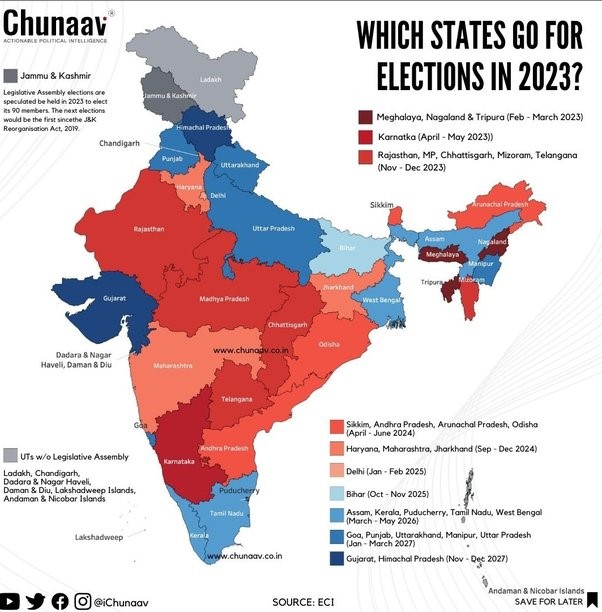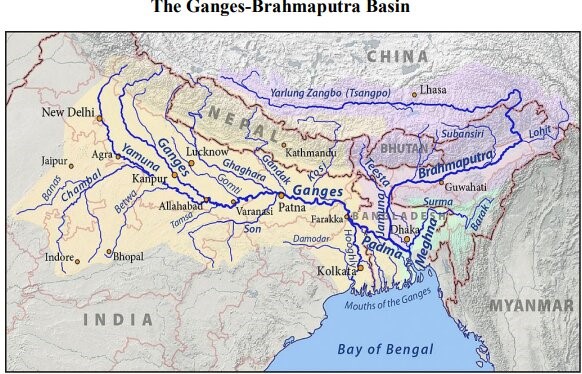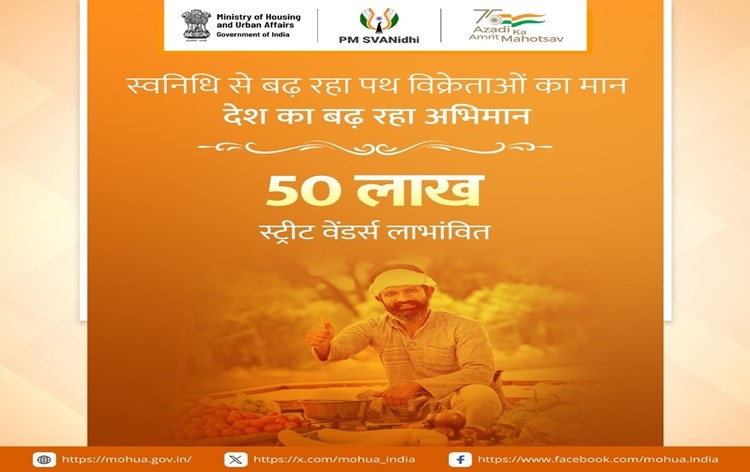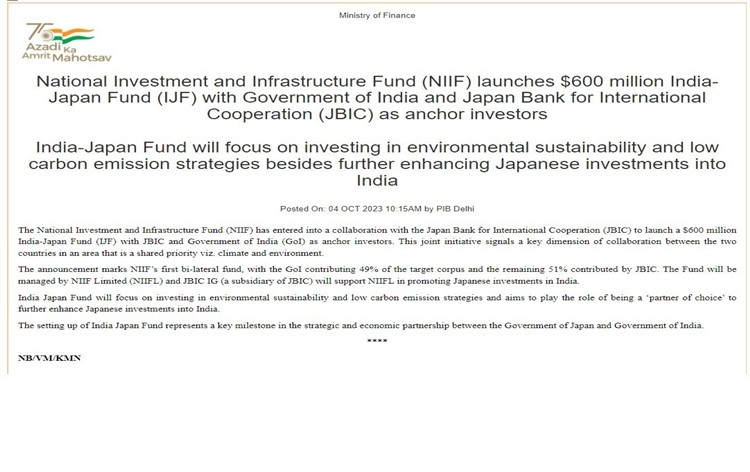UPCOMING ELECTIONS IN FIVE STATES

Context
- As the Lok Sabha elections approach, six states will witness assembly elections in 2024, while five states are gearing up for elections in 2023.
Key Details:
- Tripura, Meghalaya, Nagaland, and Karnataka have already successfully held elections this year.
- Furthermore, assembly elections are scheduled for the second half of 2023 in Mizoram, Rajasthan, Chhattisgarh, Madhya Pradesh, and Telangana.
- The Mizoram assembly election for 2023 is expected to take place later this year in November-December 2023. The legislative assembly consists of 40 members, with a majority requiring 21 seats.
- The Chhattisgarh Assembly election for 2023 is expected to be held in November this year. The Legislative Assembly comprises 90 members, representing 36 districts.
- Madhya Pradesh Assembly elections 2023 are slated to take place in or around November. A total of 230 constituencies will elect members. In the previous election held in 2018, Congress emerged as the single-largest party with 114 seats.
- The Rajasthan Assembly Elections 2023 are expected to be held in December this year. The state’s Legislative Assembly comprises 200 members, with 101 seats needed for a majority.
- The Telangana Assembly election for 2023 is expected to be held in or before December 2023. The state Legislative Assembly consists of 119 members, all of whom will be elected.
- The Andhra Pradesh election is expected to take place before June 2024 to elect all 175 members of the state’s legislative assembly.
- The Arunachal Pradesh assembly election is expected to be held in or before April 2024.
- The Odisha Legislative Assembly election is expected to be held on or before June 2024 to elect all 147 members of the state assembly.
- The Sikkim Legislative Assembly election is expected to be held on or before April 2024 to elect the 32 members of the 10th Legislative Assembly.
- The Haryana Legislative Assembly election is expected to be held on or before October 2024 to elect all 90 members of the state’s Legislative Assembly.
- The next Maharashtra Legislative Assembly election is expected to be held or before October 2024 to elect all 288 members of the state’s Legislative Assembly. The previous Assembly elections were held in October 2019.
Importance of Assembly elections in India:
| Assembly elections in India hold immense importance in the democratic fabric of the country, playing a crucial role in shaping governance at the state level. |
State Governance:
Decentralized Decision-Making:
- Assembly elections determine the composition of state legislatures, empowering elected representatives to make decisions on state-specific matters. This decentralization ensures that governance is responsive to local needs and challenges.
Policy Formulation:
- State governments have jurisdiction over a range of policy areas, including education, healthcare, agriculture, and infrastructure. Assembly elections determine the political leadership that shapes policies impacting the lives of residents in the respective states.
Representation and Diversity:
Regional Representation:
- Assembly elections contribute to regional representation, allowing diverse voices and concerns from different states to be heard in the legislative process. This ensures that the unique socio-cultural and economic aspects of each state are considered.
Cultural and Linguistic Diversity:
- India's linguistic and cultural diversity is reflected in state elections, where political parties often align with regional sentiments. This diversity is crucial for preserving and promoting the rich cultural heritage of different states.
Political Landscape and Coalition Dynamics:
Multiplicity of Political Parties:
- Assembly elections showcase the multiplicity of political parties and alliances, presenting voters with a spectrum of choices. The dynamics of multi-party systems and coalition politics at the state level influence governance and policy outcomes.
Role in National Politics:
- State elections are often viewed as indicators of the political mood and trends in the country. The performance of political parties in state elections can impact their standing in national politics.
Empowerment of Local Communities:
Local Development Initiatives:
- State governments are responsible for implementing development programs and initiatives. Assembly elections empower local communities to choose leaders who align with their vision for development and welfare.
Panchayati Raj Institutions:
- Assembly elections are linked to local governance through Panchayati Raj Institutions. The coordination between state legislatures and local bodies is essential for effective and inclusive governance.
Social Justice and Inclusivity:
Reservation Policies:
- State governments have the authority to implement reservation policies for marginalized communities. Assembly elections determine the leadership that shapes and enforces these policies, contributing to social justice and inclusivity.
Representation of Women:
- Assembly elections also impact the representation of women in state legislatures. Efforts to enhance gender diversity and women's participation in governance are influenced by the electoral outcomes.
Electoral Practices and Democratic Values:
Free and Fair Elections:
- The conduct of assembly elections showcases the commitment to free and fair electoral practices. The Election Commission plays a vital role in ensuring the integrity of the electoral process.
Democratic Values:
- Assembly elections reinforce the democratic principles of representation, accountability, and the peaceful transfer of power. The acceptance of election results reflects the maturity of India's democratic institutions.
Drawback of Assembly elections in India:
Electoral Expenditure:
Uncontrolled Spending:
- Assembly elections in India often witness uncontrolled and exorbitant spending by political parties and candidates. This can lead to a skewed playing field, favoring those with greater financial resources.
Influence of Money Power:
- The excessive use of money in elections can lead to the influence of money power over the democratic process. Candidates with significant financial backing may gain undue influence, compromising the democratic ideals of equal representation.
Exclusion of Candidates without Financial Resources:
- High electoral expenditure can discourage candidates with limited financial resources from participating, limiting the diversity of candidates and ideas in the electoral arena.
Identity Politics:
Caste and Religious Polarization:
- Assembly elections in India sometimes witness the exploitation of caste and religious identities for electoral gains. This can lead to polarization and the creation of vote banks based on identity rather than merit or policy.
Regionalism and Parochialism:
- Some elections witness the foregrounding of regional interests over national priorities, leading to parochial politics that may hinder overall development.
Lack of Policy-Based Debates:
- Elections sometimes suffer from a dearth of substantive policy-based debates, with parties relying more on identity-based appeals than discussions on developmental issues.
Vote-Bank Politics:
Short-Term Populism:
- Some parties resort to short-term populism to appease specific vote banks, offering immediate benefits without considering the long-term impact on governance and fiscal responsibility.
Neglect of Minority Concerns:
- Vote-bank politics sometimes results in neglecting the concerns of minority communities, as political parties may prioritize policies that cater to the majority for electoral gains.
Policy Paralysis:
- Vote-bank politics can result in policy paralysis, where decision-making is driven more by electoral considerations than the long-term welfare of the populace.
Criminalization of Politics:
Candidates with Criminal Records:
- Assembly elections sometimes witness the fielding of candidates with criminal records, raising concerns about the criminalization of politics.
Nexus Between Crime and Politics:
- The nexus between crime and politics can compromise governance, with individuals with criminal backgrounds influencing policy decisions for personal gain.
Fear and Intimidation:
- Candidates with criminal affiliations may use fear and intimidation tactics during elections, undermining the democratic principle of free and fair participation.
Role of the Election Commission in conducting Assembly elections in India:
Electoral Planning and Preparation:
Conducting Voter Registration:
- The Election Commission oversees the compilation and maintenance of electoral rolls, ensuring eligible citizens are registered to vote.
Delimitation of Constituencies:
- The Election Commission is responsible for periodic delimitation of constituencies, ensuring a fair distribution of representation based on population changes.
Election Schedule and Notification:
- It formulates and announces the election schedule, specifying key dates such as filing nominations, scrutiny, and polling day.
Implementation of Model Code of Conduct:
Enforcement of Ethical Guidelines:
- The Election Commission implements the Model Code of Conduct, setting ethical standards for political parties and candidates during the election period.
Monitoring Campaign Expenditure:
- It monitors and regulates campaign expenditures to prevent the misuse of financial resources, ensuring a level playing field for all candidates.
Election Machinery and Logistics:
Appointment of Election Officials:
- The Commission appoints election observers, returning officers, and polling personnel to oversee the electoral process impartially.
Security Arrangements:
- It collaborates with law enforcement agencies to maintain law and order, ensuring a secure environment for voters and candidates.
Logistical Coordination:
- The Commission coordinates with various authorities to ensure the availability of polling booths, electronic voting machines (EVMs), and other essential materials.
Voter Education and Awareness:
Voter Education Programs:
- The Commission conducts voter awareness campaigns to educate citizens about the electoral process, voting rights, and the significance of participation.
Facilitating Inclusive Voting:
- It takes measures to ensure the inclusion of marginalized groups, providing facilities for differently-abled voters and those in remote areas.
Monitoring and Addressing Electoral Malpractices:
Surveillance and Action against Violations:
- The Commission monitors activities that violate election laws and takes prompt action against malpractices to maintain the integrity of the electoral process.
Complaint Redressal:
- It establishes a mechanism for receiving and addressing complaints related to electoral malpractices, ensuring a fair and transparent resolution.
Closing thoughts
- "One nation, one election" is a significant electoral reform proposal in India. While it offers potential benefits such as cost reduction and governance continuity, addressing constitutional and logistical challenges and gaining political consensus is critical for its successful implementation. The way forward involves careful planning, legal amendments, and transparent public engagement.
https://newsonair.com/2023/10/03/election-commission-to-review-preparations-for-assembly-elections-in-telangana/
https://www.financialexpress.com/india-news/upcoming-elections-in-india-2023-24-which-are-the-states-scheduled-to-go-to-polls-around-lok-sabha-elections-full-list-here/3258603/
https://www.tribuneindia.com/news/india/importance-of-upcoming-assembly-elections-to-five-states-why-bjp-and-congress-taking-extra-precaution-549710
.jpg)
Flash flood in Teesta River
Context
- In Sikkim, Glacial Lake Outburst Flood in parts of Lhonak Lake, Mangan District resulted in the rise of water levels along the Teesta River Basin in the early hours today causing a flash flood.

Details
- State Disaster Management Authrity (SSDMA) has informed this. In Pakyong district, 23 army personnel have been missing and one person has been rescued at Bardang, where some vehicles are submerged under slush.
- All emergency services are deployed for evacuation of people to safer areas.
- Severe damages have been reported in Mangan, Gangtok, Pakyong and Namchi Districts. Many bridges have collapsed and houses washed away
About Flash flood:
- The US’s meteorological agency, the National Weather Service, says flash floods are caused when rainfall creates flooding in less than 6 hours. It adds that flash floods can also be caused by factors apart from rainfall, like when water goes beyond the levels of a dam.
- In India, flash floods are often associated with cloudbursts – sudden, intense rainfall in a short period of time.
- Himalayan states further face the challenge of overflowing glacial lakes, formed due to the melting of glaciers, and their numbers have been increasing in the last few years.
How common are flash floods and floods?
|
Data from Assam State Disaster Management Authority
|
·According to government data from a project by the Assam State Disaster Management Authority, India is the worst flood-affected country in the world after Bangladesh and accounts for one-fifth of the global death count due to floods.
|
|
NDMA Data
|
·National Disaster Management Authority states that one of the reasons for flood situations occurring so frequently, is that nearly 75 per cent of the total Indian rainfall is concentrated over a short monsoon season of four months (June to September).
|
|
National Flood Commission Data
|
·About 40 million hectares of land in the country are liable to floods according to the National Flood Commission, and an average of 18.6 million hectares of land are affected annually.
|
|
Concern
|
·Flash floods may in the future, begin to take place after wildfires that have been taking place more frequently. This is because wildfires destroy forests and other vegetation, which in turn weakens the soil and makes it less permeable for water to seep through.
|
|
About Teesta River
|
·Teesta river is a tributary of the Brahmaputra (known as Jamuna in Bangladesh), flowing through India and Bangladesh.
·It originates in the Himalayas near Chunthang, Sikkim and flows to the south through West Bengal before entering Bangladesh.
|
https://newsonair.gov.in/News?title=Flash-flood-in-Teesta-River-due-to-glacial-outburst-causes-severe-damage-in-Sikkim%3b-Several-people-missing-including-23-Army-personnel&id=468841

PM SVANidhi scheme
Context
- Prime Minister Narendra Modi has lauded the PM SVANidhi scheme which has crossed the milestone of 50 lakh beneficiaries.

Disclaimer: Copyright infringement not intended
About PM SVANidhi scheme:
- The Prime Minister Street Vendor’s AtmaNirbhar Nidhi (PM SVANidhi) was launched by the Ministry of Housing and Urban Affairs in June 2020.
- The main objective of the scheme is to provide affordable Working Capital loans to street vendors to restart their livelihoods that have been adversely affected due to the Covid-19 lockdown.
- Vendors can get collateral-free working capital loans up to ₹10,000, which are repayable in monthly installments in term of one year.
- An enhanced loan of up to ₹20,000 and ₹50,000 on the second and third times respectively, on repayment of earlier loans.
- On timely/ early repayment of the loan, an interest subsidy at the rate of 7% per annum will be credited to the bank accounts of beneficiaries through Direct Benefit Transfer quarterly.
- There will be no penalty for early repayment of the loan.
- The scheme promotes digital transactions through cashback incentives up to an amount of Rs. 100 per month.
- The vendors can avail of the facility of escalation of the credit limit on timely/ early repayment of loans.
https://newsonair.gov.in/News?title=PM-SVANidhi-scheme-not-only-made-lives-of-street-vendors-easier-but-has-also-given-them-opportunity-to-live-with-dignity%2c-says-PM-Modi&id=468846
India-Japan Fund
Context
- The National Investment and Infrastructure Fund and Japan Bank for International Cooperation, JBIC have tied up to launch a 600 million US dollar India-Japan Fund.

Details
- This joint initiative will facilitate collaboration and investment between India and Japan in the field of climate and environment.
- According to the Finance Ministry, the Government of India will contribute 49 per cent of the corpus and the remaining 51 per cent will be contributed by JBIC.
- This fund mechanism will promote Japanese investments in India by focussing on investing in environmental sustainability and low carbon emission strategies.
- The Finance Ministry has termed this collaboration a key milestone in the strategic and economic partnership between India and Japan.
About the National Investment and Infrastructure Fund:
|
About
|
·National Investment and Infrastructure Fund (NIIF) is India’s first infrastructure-specific investment fund or a sovereign wealth fund that was set up by the Government of India in 2015.
|
|
Objectives
|
·The objective behind creating this fund was to maximize economic impact mainly through infrastructure investment in commercially viable projects, both greenfield and brownfield.

|
|
Governing Council
|
·The Governing Council of the NIIF is chaired by the Hon’ble Finance Minister of India and has members from corporate bodies, investments, and policy sectors.
·The Governing Council meets once a year and provides suggestions for the overall strategic decisions of the NIIF.
|
|
Funds
|
·NIIF manages three funds: Master Fund, Fund of Funds, and Strategic Fund. The funds were set up to make investments in India by raising capital from domestic and international institutional investors.
|
https://newsonair.gov.in/News?title=NIIF-and-JBIC-launch-600-million-India-Japan-Fund-to-facilitate-collaboration-and-investment-in-field-of-climate-and-environment&id=468843

Shalban Buddhist Vihar
Context
- High Commissioner of India to Bangladesh Pranay Verma on Tuesday visited Shalban Buddhist Vihar located in Cumilla District of Bangladesh.
Details:
- The High Commissioner also visited the Mainamati Museum located in the south of Shalbon Vihara.
- Verma discussed with the curator and local administrative officers about the excavations, upkeep and preservation of Shalban Vihar archaeological site and Mainamati Museum
About the Shalban Buddhist Vihara:
- Shalban Buddhist Vihara is located in the Lalmai-Mainamati region of the Cumilla district, is one of the archaeological sites of the ancient civilization of undivided India.
- The ruins of Buddhist temples and viharas were uncovered in this archaeological site known as 'Shalban Vihara during archaeological excavations conducted at different times. The actual name of Shalban Vihara is 'Sri Bhabadeva Mohavihara.
- This Mohavihara was built by the fourth King Shri Bhabadeva during the rule of the Deva dynasty from the middle of the seventh to the eighth century CE.
- The length of each side of the square vihara is 168 meters. The Vihara has a total of 115 monk's rooms in its four arms and a temple in the middle. Several smaller temples and ruins of stupas are uncovered around the central main temple.
- The unique attraction of this Vihara is the ruins of the large arcade uncovered on the north side. Four phases of ruins of construction, reconstruction, and renovation-repair at Shalban Vihara are exposed during archaeological excavations.
- Shalban Vihara is an excellent example of the complete development of Buddhist temple architecture in Bengal during the seventh-eighth centuries CE.
- Various valuable artifacts including various types of terracotta plaques, pottery, terracotta beads, bronze and clay figurines, decorated bricks, copperplate inscriptions, seals, and gold and silver coins are found during the archaeological excavations.
- These artifacts are preserved and displayed in the Mainamati Museum located in the south of Shalbon Vihara.
- The antiquities discovered in Shalban Vihara bear the memories of the ancient Bengal and Samatata towns from the seventh to the twelfth century CE.
https://newsonair.gov.in/News?title=Indian-High-Commissioner-visits-Shalban-Buddhist-Vihar%2c-Cumilla-in-Bangladesh&id=468842
.jpg)







